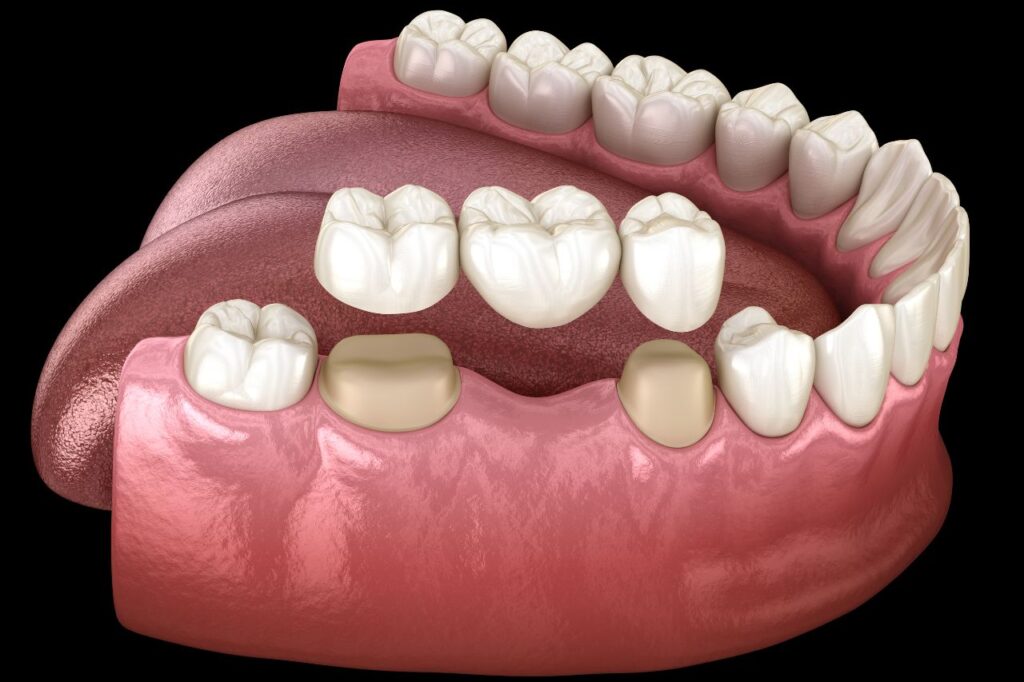What is a dental bridge?
Many people lose a tooth at some point in their lives. In fact, around 120 million American people have at least one missing tooth. There are some good dental solutions, of which the dental bridge is the most popular. What is a dental bridge, what does the procedure look like and does it hurt? Read all about dental bridges.
In This Article:
- What is a dental bridge exactly?
- Different types of dental bridges
- The procedure of getting a dental bridge
- When do you need a dental bridge?
What is a dental bridge exactly?
A dental bridge is a dental solution that bridges the gap that appears when you have lost a tooth or several teeth.
The bridge itself is made of various parts. The most important one is the ‘pontic’. This is the artificial tooth that takes the place of the missing tooth. This pontic is held in place by dental crowns that are attached to the teeth on either side of the gap, known as the ‘abutment’ teeth. The pillars of the bridge, so to speak.
Dental bridges are typically made from hard materials, like porcelain or ceramic. Some are resin-based. These materials are strong and can also match the natural color of your other teeth. This makes the bridge blend in with the rest, making it nearly impossible for others to notice you have a bridge.
A dental bridge is not only for aesthetic reasons. It’s also a functional solution. For example, it allows you to chew and speak properly. And it keeps the shape of your face the same as before. Missing teeth can sometimes alter it.
If you need a dental bridge, you’re not the only one. According to the American College of Prosthodontists, about 120 million Americans are missing at least one tooth. Perhaps not all of them have dental bridges, but dental bridges are a widely used solution for missing teeth. So there’s plenty of people that have one or more.
- You may also be interested in: Dental Bridge Vs Implant: Which Option Is Best For You?

Different types of dental bridges
When we want to answer the question: ‘what is a dental bridge’, it is essential to look at different types. There are four main types of dental bridges, each with its own unique characteristics and applications.
- Traditional dental bridge.
This is the most common type of bridge. It is made of one or more pontics (false teeth) and is held in place by dental crowns, also known as ‘abutments’. These are cemented onto the teeth adjacent to your missing tooth. Traditional bridges are a good choice when you have natural teeth on both sides of the gap, where your tooth is missing.
- Cantilever dental bridge.
Unlike traditional bridges, the cantilever dental bridge is used when adjacent teeth are on only one side of the missing tooth or teeth. The crown is only cemented to one abutment tooth. This is not a very common type of bridge. It’s usually not recommended for the back of the mouth, where it can put too much force on other teeth and damage them.
- Maryland dental bridge.
Ideal for frontal placements, this bridge, also known as a resin-bonded bridge, eschews crowns, instead employing a metal or porcelain framework bonded to adjacent teeth. Since this type of bridge does not require crowns, the supporting teeth do not need to be filed.
- Implant-supported dental bridge.
These bridges use dental implants instead of crowns or frameworks. Typically, one implant is surgically placed for every missing tooth. It’s these implants that hold the bridge in position. If it’s not possible to place one implant for every missing tooth, the bridge will have a pontic between two implant-supported crowns.
The choice of the type of bridge depends on different factors, such as the location of the missing tooth and the condition of the teeth adjacent to the gap. Of course, you’re best to discuss these options with your dentist. Together we determine the most suitable solution for your teeth.
The procedure of getting a dental bridge
Getting a dental bridge involves a series of steps that are typically completed over two dental visits.
First: preparation
The first step the dentist will take is to prepare the teeth on either side of the gap. We reshape these teeth by removing a portion of their enamel, by filing them. This is necessary, so there’s room for a crown to be placed over them. This is usually done under local anesthesia.
Once the teeth are prepared, we will make an impression of your teeth. This serves as the model from which the dental lab will create your bridge.
A temporary bridge will be placed on them to protect your reshaped teeth while your permanent bridge is being made.
Second visit: placement
During your second visit, the temporary bridge is removed. After that, the new bridge is fitted and, if necessary, adjusted to achieve a proper fit. Once the fit is right, the bridge is cemented into place.
After the procedure, your dentist will give you instructions on how to care for your new bridge. Good dental health is always part of that.
Is it painful to get a dental bridge?
The process of getting a dental bridge is usually not painful. Often, local anesthesia is used during the procedure to numb the area, to minimize discomfort.
However, it’s normal to experience some sensitivity after the procedure. This is temporary and can be managed with over-the-counter pain relievers. Make sure to follow the aftercare instructions that your dentist provided. This helps a quick recovery and keeps discomfort to a minimum.

When do you need a dental bridge?
A dental bridge might be necessary when you have one or more missing teeth. The missing tooth can have various reasons, such as severe tooth decay or cavities, an accident that damages a tooth beyond repair, or an infection that has spread.
Getting a dental bridge can bring several benefits. For one, it helps restore your smile. For many, this helps with self-confidence as well. It also fills the gap left by the missing tooth, preventing the remaining teeth from shifting. This is important because shifting teeth can lead to problems with biting and chewing.
Missing teeth can affect your speech and even alter the shape of your face. A dental bridge prevents these issues.
The longevity of the bridge
The lifespan of a dental bridge varies. On average, a dental bridge lasts between five and fifteen years. With good oral hygiene and regular dental check-ups, it’s perfectly possible for a dental bridge to last more than 10 years. Some dental bridges have even been known to last over 20 or even 30 years.
